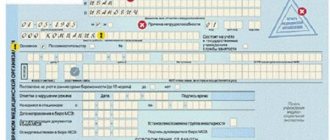The concept of ability to work is used in two cases - when we are talking about reaching the age at which it becomes possible to carry out work, and when we are discussing the state of a person’s health, which allows or, conversely, does not allow to work and earn income. It turns out that disability characterizes the onset of a situation in which the performance of official functions becomes impossible forever or for a certain period of time. Let's take a closer look at the concept and types of temporary disability.
What guarantees does an employee have?
Within the framework of the norms of Article 183 of the Labor Code of the Russian Federation, during a period of temporary incapacity for work, an employee retains his position, and is also assigned a benefit payment in the amount of average earnings. However, the fact of the development of a disease is not always the basis for assigning a payment. In order to qualify for compensation, a citizen must pay monthly insurance contributions to the Social Insurance Fund.
At the same time, in accordance with the norms of Federal Law No. 255, not only citizens employed under an employment contract can apply for payment, but also:
- lawyers;
- entrepreneurs;
- state and municipal employees;
- persons recognized as unemployed, but only in a number of cases;
- citizens who issued sick leave no later than 30 days after dismissal.
Causes and signs of temporary disability
Temporary disability, unlike other types of social security, has a number of individual characteristics:
- legal justification for the inability to perform labor duties due to the occurrence of an insured event, enshrined in Article 5 of Federal Law No. 255;
- assignment of benefits as compensation for lost earnings;
- calculation of benefits in the average amount from a citizen’s earnings;
- regulated deadlines for completing the sheet, submitting it at the place of work, and paying benefits;
- sources of accruals from the Social Insurance Fund and employer funds.
Within the framework of Federal Law No. 255, an employee may be recognized as disabled for the following reasons:
- sustaining an injury or developing a disease, including complications after an abortion;
- caring for a close relative;
- stay in quarantine of an employee or a member of his family;
- prosthetics;
- Spa treatment.
Disability classification
According to the temporary criteria of failure, reversibility of the process and severity, disability is classified by a number of parameters:
- By duration:
- temporary - inability to perform certain functions due to physical health conditions or due to the influence of social factors during a specifically established period of time with signs of complete reversibility of the process within the time frame predicted by medical institutions;
- permanent (persistent) – inability to perform assigned duties due to long-term reasons with a high probability of not being restored and receiving the status of “disabled person”. From a medical point of view, permanent disability is a long-term or permanent loss of ability to work as a result of an illness, injury or anatomical defect that led to pronounced disturbances in physiological processes.
- According to the degree of preservation of the functions performed:
- partial – a restriction in the performance of a number of professional obligations, requiring the employer to transfer to easier physical or mental labor with release from part of the work performed in accordance with the employment contract;
- complete - exclusion of the range of obligations for a certain period during which therapy is carried out and temporary disability is established.
- By type of activity:
- professional – restriction of execution of certain types of work performed. For example, a ban on physical labor for diseases of the cardiovascular system, a taboo on training for injured athletes;
- general – transition to a special hospital regime, incompatible with any type of activity.
Temporary and permanent, professional and general, partial and complete disability are parameters that determine the likelihood of restoration of lost functions during the rehabilitation period and return to full-time work.
Kinds
Types of temporary disability can be divided into:
- medical;
- social;
- preventive.
Each of them includes a number of insured events, determined by the norms of Article 5 of Federal Law No. 255.
Disease
A citizen is recognized as temporarily disabled due to illness in the event of loss of the opportunity to work personally due to impaired body functions or injury. By virtue of Article 5 of Federal Law No. 255, abortion and artificial insemination are also considered diseases that lead to loss of ability to work.
Accident at work and at home
Industrial and household injuries, despite similar signs of loss of ability for the worker personally, differ significantly from the standard case of the disease. By virtue of Article 228 of the Labor Code of the Russian Federation, the circumstances preceding the injury are subject to a thorough investigation.

If an illness or injury occurs at an enterprise, compensation is calculated at 100% of average earnings, regardless of length of service. Also, in pursuance of Federal Law No. 125, the company compensates for all costs of treatment, including rehabilitation, and also pays compensation.
Pregnancy, abortion and childbirth
Combining work with motherhood is one of the social guarantees provided by law. Within the framework of the norms of Federal Law No. 255, a woman has the right to issue a sick leave at 30 weeks of pregnancy for a period of 140 to 196 days in the event of a multiple pregnancy or complications arising during pregnancy. An additional guarantee for women established by Article 11 of Federal Law No. 255 is the amount of benefits, which is calculated based on 100% of average earnings for any length of service.
Quarantine announcement
Medical measures for the introduction of quarantine are carried out within the framework of the norms of Article 31 of Federal Law No. 52, only in the event of the occurrence of infectious diseases, the list of which is defined by law. At the same time, measures to limit communication in the form of quarantine are introduced if:
- the employee is a carrier, even a latent one;
- the citizen had contact with a sick person.
The need to care for a sick family member or relative
Children most of all need help and care, so parents most often issue sick leave to care for a family member just for them. Federal Law No. 255 spells out in sufficient detail both the deadlines for registering a period of incapacity for work per year and the amount of benefits depending on length of service. But Federal Law No. 255 also allows for the issuance of a certificate when an adult relative, for example, an elderly mother, is ill for up to 30 days a year.
Referral to sanatorium-resort treatment

The need for additional recovery after illness is determined only by a medical institution if there are certain indications. An employee’s desire to simply rest is not enough. In accordance with the norms defined in clause 2 of article 6 of Federal Law No. 255, the attending physician not only issues a sick leave certificate, but also a referral to a sanatorium. In this case, the treatment period cannot exceed 24 days. With tuberculosis, the length of recovery may be longer.
Adoption of foster children
By virtue of the norms of Article 257 of the Labor Code of the Russian Federation, a woman who has adopted a newborn baby is granted leave from the date the adoption decision enters into force until the child is 70 days old. At the request of the mother, this period can be replaced by leave under the BiR for the same period, followed by the issuance of a certificate of incapacity for work. If two children are placed under guardianship as twins, the certificate is issued for 110 days.
Rehabilitation after various medical procedures
Rehabilitation after surgical treatment or other medical procedures within the framework of the standards of Order of the Ministry of Health No. 279N is carried out as a type of sanatorium-resort treatment. Thus, a citizen can be sent to any sanatorium or rehabilitation center if there is a referral and an open certificate of incapacity for work for a period of no more than 24 days.
Prosthetics
The procedure for performing prosthetics and designing a sheet is regulated by the norms of Part 7, Article 6 of Federal Law No. 255. A person in need of prosthetics, upon the direction of the attending physician, enters the clinic for a preliminary consultation, selection of a prosthesis and its installation. In this case, the period of incapacity includes not only the listed activities, but also the travel time, according to the date of departure and arrival on the tickets.
Suspension from work

An employee can be suspended from performing duties only in cases specified in Article 76 of the Labor Code of the Russian Federation. In this case, regardless of whose fault the person was unable to start work, a certificate of incapacity for work is not issued. Order of the Ministry of Health and Social Development of the Russian Federation No. 624n contains an exhaustive list of grounds for issuing sick leave, in which citizens are recognized as temporarily disabled.
Documents for processing compensation
The list of documents, as well as the duration of temporary disability, greatly depends on the cause of loss of ability to work. If she has a medical reason (illness, pregnancy and childbirth, abortion, IVF, prosthetics, surgery, spa treatment, etc.), an approximate package of documents will be as follows:
- sick leave;
- medical certificate No. 095/095U;
- certificate of form No. 027/027U for students wishing to receive academic leave;
- a certificate from a doctor in any form (it must have the seal of a government agency and the doctor’s signature).
Based on these documents, the person receives a certificate of incapacity for work, which he must submit to his place of work.
Important: if a person becomes temporarily disabled due to suspension, the need to care for a sick relative, or for another reason, the list of required documents changes. It is better to clarify this directly when applying for benefits.
Documentation of temporary disability

Loss of ability to work does not in itself entail the assignment of benefits without documentation, as determined by the norms of Order No. 624n. If citizens apply to a medical institution for medical care, a number of mandatory documents are drawn up:
- personal card with a record of complaints, symptoms and possible diagnosis;
- referral for examination, if necessary;
- certificate of incapacity for work with the corresponding coding and other data, the list of which is determined by section 9 of Order No. 624n.
A sick leave certificate for temporary partial disability opens on the day the citizen goes to the hospital and closes on the day the treatment ends. If restoration of health involves a period exceeding 15 days, the decision to extend the certificate is made by the IHC commission. After 4 months, in case of permanent disability, the person may be assigned a disability group.
Important: In case of temporary total disability, sick leave can be extended for a maximum period of one year, but only if a complete recovery is expected.
Concept and types of temporary disability: difference from permanent disability
Permanent disability is otherwise called disability. But the disabled group is also assigned either permanently or temporarily. Permanent disability is divided not only into complete and partial, but has a rather long period. If, based on the results of a medical and social examination, an employee is assigned a disability, this entails some legal and social consequences, namely:
- complete refusal to work or restriction in performing labor functions;
- the emergence of the right to a pension and benefits;
- right to take additional courses vocational education;
- emergence of rights to labor benefits.
The attending physician cannot recognize a person as disabled - he only refers him to undergo a medical and social examination. MSEC specialists solve the following tasks:
- establish a disabled group;
- determine whether the patient needs social protection;
- approve an individual rehabilitation program;
- are sent to courses in the profession. retraining due to the inability to return to previous activities.
When making a decision on assigning a disabled group, the following person’s capabilities are assessed:
- self-care without outside help;
- movement and orientation in space;
- carrying out labor activities;
- ability to learn;
- control of one’s actions and actions;
- communication.
In some cases, disability is permanently established - in such a situation, passing the commission again is not required. But in most cases, MSEC is carried out regularly in order to check a person’s condition for changes for the better or for the worse. If there is a chance that the ability to work will ever be restored, the person will have to appear for examination at the appointed time. If you fail to appear for a medical examination without a good reason, your disability will be removed, which means your pension and benefits will be cancelled.
Features of registration of temporary disability
In pursuance of section 9 of Order No. 624n, the sick leave must contain a number of mandatory information. In particular, the coding on which the size of the benefit depends. After receiving the sheet in hand, it is handed over to the employer, who, in turn, according to the rules, will fill out the reverse side, entering the following data:
- experience;
- the number of working days and days off during the period of incapacity;
- total number of hours during illness;
- benefit calculation.
In this case, the sheet will not be accepted if:
- contains corrections;
- the encoding is not set;
- there are errors in the name of the company or employee data;
- the length of the period of illness exceeds the norms approved by law.
Important : For each insured event, there are maximum periods of incapacity for work in the context of a single case and an annual limit. If the deadlines are violated, the slip will not be accepted for payment.
Answers to common questions about the concept and types of temporary disability
Question No. 1: Is it possible to extend the sick leave issued upon discharge from the hospital?
Answer: If, after inpatient treatment, follow-up treatment is required on an outpatient basis or in a sanatorium, then an extension of sick leave is allowed.
Question No. 2: I am a carrier of a dangerous disease and I myself do not feel unwell, but the attending physician forbade me to go to work, is this legal?
Answer: The doctor’s actions are based on the law, since your condition is dangerous for others.
Procedure for assigning temporary disability benefits

The procedure for applying for sickness benefits at an enterprise is quite simple and consists of just a few steps:
- submitting the sheet to the accountant;
- calculation of length of service by the HR department;
- calculation and accrual of benefits by the financial department;
- submitting an application to the Social Insurance Fund for the allocation of funds;
- payment of compensation.
Important : In compliance with the norms of Federal Law No. 255, the establishment of benefits depends on the transfer of contributions to the social insurance fund. If an employee refuses to pay them, he will be denied sick pay.
Temporary disability without benefits
All cases of loss of ability to work for persons employed in official employment are documented through a sick leave certificate. But the period of health restoration is not subject to payment in all cases. So, within the framework of Article 9 of Federal Law No. 255, benefits are not assigned to:
- during periods of absence from work for legal reasons, with the exception of annual leave;
- upon suspension from work;
- upon arrest;
- during the forensic medical examination;
- during downtime.
Also, appointment will be denied if:
- the employee caused harm to himself, for example during a suicide attempt;
- suffered while committing a criminal offense.
Important : Women on maternity leave are not issued sick leave at all.
Criteria for dividing cases of temporary disability into types
Cases of temporary disability are divided into several types. In this case, the distinction is made according to certain criteria:
| Criterion | Description |
| Degree of ability to work | A distinction is made between complete and partial loss of ability to work. In the first case, for an employee who suffers an illness or injury, any work at all is excluded. This happens when it is necessary to comply with a special regime of hospital stay. In the second case, the doctor prohibits the performance of certain functions, for example, you cannot lift heavy objects after a broken arm. In such a situation, it is permissible not to completely deprive a person of the opportunity to work, but to issue a sick leave with an order to transfer the patient to another job. |
| Type of work activity | There are general and professional activities. In the first case, the employee is prohibited from going to work in principle. The doctor makes such a decision in two cases - if the patient is seriously ill, and if the disease is contagious and can harm the person’s environment. In the second case, the doctor prohibits working in a certain field of activity. For example, the cause may be a contagious disease of the person himself or one of his relatives, as a result of which the patient became a carrier of the virus. |
| Chance of health recovery | A distinction is made between permanent and temporary disability. In the first case, you will never be able to return to work or for a very long time. In the second case, after a short period of time, working capacity is completely restored. |
Procedure for deprivation of temporary disability benefits
Article 8 of Federal Law No. 255 provides the grounds on which an employer can reduce the amount of benefits. In particular:
- violation of treatment regimen;
- avoidance of following doctor's orders;
- failure to appear for a scheduled examination;
- being in a state of alcoholic intoxication.
In such situations, the payment amount is reduced to the minimum wage according to the coding that reflects the violations. At the same time, it is unacceptable by law to reduce the amount of benefits based only on a sheet. In such a situation, a protocol of the social insurance commission must be drawn up, which confirms the validity of the reduction in compensation. If an employee is refused sick leave, a protocol is also drawn up.
What is temporary disability according to the Labor Code of the Russian Federation?
In the Russian Federation, all labor relations are regulated by the Labor Code. All nuances that relate to temporary disability are regulated by Federal Law No. 255-FZ “On compulsory social insurance in case of temporary disability and in connection with maternity.” This law has been in effect since December 29, 2006.

In fact, a certificate of temporary incapacity for work can be called a sick leave issued in accordance with all legal rules.
Arbitrage practice

Controversial issues regarding payment for periods of incapacity by employers are focused on the following areas:
- dismissal during illness;
- refusal to pay during forced absence;
- deadlines for submitting and paying sick leave.
As judicial practice shows, positive and negative decisions are approximately equally divided between employees and insurers. This situation is due to the fact that ordinary workers cannot always prove their case with reason and provide documentary evidence.









